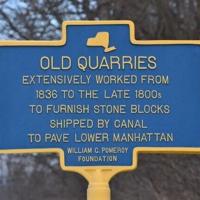LOOKING BACK: The 1869 prize fight in Covert | Lifestyle

[]
In the early summer of 1869 in southeastern Seneca County, there occurred a sensational, yet tragic event: the notorious Prize Fight that is detailed in the book, “The Town of Covert: Early History.”
For many years, Patrick Donnley (some sources spell his last name as Donnelly or Donley) and Patrick McGraw had boasted of their physical strength loudly, each claiming that he could whip the other in a fight. Perhaps it was inevitable they would fight each other to prove which Patrick was telling the truthful boast.
Before talking about this prize fight, a key piece of information must be shared. At that time in this greater area of Covert and Ulysses, there were several stone quarries. Quarry work was hard labor, and many of the quarry workers became strong and muscular. These two Patricks in this prize fight were laborers at two different quarries; it’s no surprise that natural rivalries might arise between these several quarries.
Initially, the actual fight between Patrick Donnley and Patrick McGraw was to take place in Farmer Village. However, Constable Conover learned of this plan and told the pair they would be arrested if they actually fought. Conover, like many area residents, remembered clearly that two years prior there had been a “fracas” in which one man had been “pounded to death” by another man, who was eventually acquitted on the grounds of self-defense. Conover didn’t want a repeat tragedy, so he mediated and convinced the two men to shake hands and shelve their fight plans.
But our tale doesn’t end there.
Apparently, local “rowdies” were anxious to make bets on such a fight. Their urging resulted in a contested fight being arranged for the two Patricks for June 12, 1869, at the Kingtown Stone Quarries. At the appointed hour, a rope was stretched and the two Patricks shook hands and agreed to a fair stand-up fight.
Patrick Donnley, however, kicked his opponent in the abdomen, clinched him, and struck a blow partly in the back of the neck, bursting a blood vessel. Patrick McGraw fell to the ground and died in less than two minutes. Donnley grabbed a horse and escaped, and a warrant was issued. On Sunday afternoon, Deputies Wheeler and Stout set out to find and arrest Donnley. That evening, probably in his effort either to hide or elude arrest, Donnley fell from a precipice into the ravine near the Osborn Sawmill in the town of Ovid. He hit a ledge of rocks in his nearly 90-foot fall, severely cutting his knee, but managed to reach the nearby residence of his father, Mathew Donnley, who summoned the aid of a physician.
Donnley surrendered to Deputies Wheeler and Stout the next morning.
‘Disgraceful conduct’Donnley was taken into custody and brought to the Seneca County Jail at Ovid Village at the same time the funeral procession for McGraw was proceeding to the cemetery. The Rev. Terrance Keenan, pastor of Holy Cross Church at Ovid, refused to officiate at McGraw’s funeral or permit the body to be buried in the family lot in the Catholic cemetery. McGraw’s relatives tried to persuade Keenan to change his mind, arguing that McGraw was to have been married the following Sunday and that Keenan should overlook his disdain for the disgraceful conduct of these two men undertaking a public prize fight. Keenan, however, stood fast in his decision.
At the coroner’s inquest, Arthur Woods was accused of being an accessory. It was reported that Woods was McGraw’s “second” in the prize fight. The inquest determined that McGraw commenced the fight during the hand-shaking. McGraw inflicted such heavy blows on Donnley that after three or four times of being knocked down, Donnley said he was done fighting. At that point, Woods took out his pistol and told Donnley he must whip McGraw. Woods also warned that he would shoot anyone in the audience who tried to interfere with the continuation of the fight. It was also reported that Woods kicked McGraw several times when he was down.
Donnley pled guilty to third-degree manslaughter in April 1870 in Seneca County Court and was sentenced to four years in the Auburn state prison. On May 3, 1870, Seneca County Undersheriff John T. Stout escorted Donnley to Auburn to start serving his sentence.
To put this prize fight into some perspective, in 1859 a New York state law banned promoting and engaging in “ring or prize fights.” That fact helps to explain why Constable Conover had warned the two Patricks that he would arrest them if they did fight.
In 1896, the Horton Law legalized boxing in New York state. Boxing in New York state continued on a club membership basis only until 1911. In a series of new state laws in 1911, including the Frawley Act, 10-round bouts of boxing were allowed. In 1917, the Slater Bill outlawed boxing in the state. Then, in 1920, New York state adopted the Walker Law, which legalized boxing again and established the New York State Athletic Commission. This law became the model for many other states and local governments throughout the United States.
Walt Gable is the Seneca County historian.


